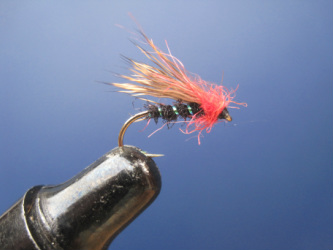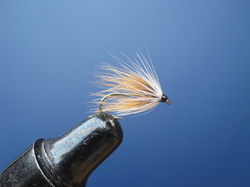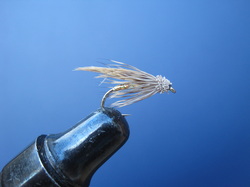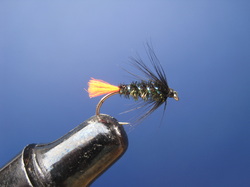The summer cast
by Mark Sandison
Fly fishing in the summer months in Shetland can often be a tricky business. This is especially so in July when the lochs can often experience the “doldrums” after a period of warm, calm and settled weather. Such conditions can mean the trout becoming quite torpid and reluctant to come to the fly. This situation will be made worse by any days of unbroken sunshine when an angler’s only hope might be to plumb the depths with a sinking line. A freshening of the weather into August however and sport can be expected to pick up again especially if there is some wind to stir things up a bit.
The summer months however are often characterised by the wind falling away in the evening leaving only a ripple or flat calm on the lochs. Beautiful and idyllic perhaps, but also difficult conditions in which to tempt a trout - especially if they aren’t rising. During July and August though this time of day might provide the best opportunity to catch a fish as they start to feed after the heat has gone out of the day and the sun is setting. It is with these still evenings in mind that I have selected my summer cast.
On the top dropper is the “Bibio Half Hog.” Half Hogs, as the name suggests are really just scaled down hedgehogs but fulfil a completely different role. Half hogs are simple to tie and are very effective in calm conditions, especially when targeting rising fish. Some anglers will gink the wing so that they hover in the surface film when first cast before twitching them back with a slow retrieve. Takes will often come just as they dip beneath the surface. I have selected the “Bibio Half Hog” as I always like to have a black fly on my cast in this situation to represent the many nondescript dark flies, including midge, which will be in evidence on and around the loch. However it is also worth having Half Hogs in your box in claret, olive and orange.
For middle dropper I have chosen another very simple but deadly fly, the “Anorexic Loch Ordy.” This has to be one of the easiest flies to tie being nothing more than two hen hackles wound in at the eye of the hook. In this case however simple really is effective and this is a superb fly in calm conditions either fished speculatively or cast to rising fish. Again it is at its best when twitched back slowly and is especially effective when small light sedges, so often seen in the summer, are on the go.
On the tail is a great all rounder, the “Gold Muddler.” This fly can be representative of many food items on the trout’s menu or simply fished as a general attractor. The “Gold Muddler” will work in most sizes and most conditions but is particularly effective in the calm when tied small and sparse.
Other flies to try might include, Greenwell Spider, Black Pennel, Black Spider, One Fish Zulu, Anorexic Kate, Diawl Bach, Cormorants, Hoppers, and buzzer patterns.
With all of these twiddly flies “sparse” is the key word. Overdressing them will severely lessen their trout catching abilities in calm conditions. Less is definitely more as far as these summer evening flies go. Local anglers will often fish these patterns on a midge tip or slow intermediate line to avoid surface disruption – especially if there is little sign of rising fish.
Bibio Halfhog

Thread – Black
Body – Black SLF or similar.
Rib – Oval silver or fine pearly.
Wing – Small bunch of deer hair.
Head – Red SLF or similar.
Body – Black SLF or similar.
Rib – Oval silver or fine pearly.
Wing – Small bunch of deer hair.
Head – Red SLF or similar.
Anorexic Ordie

Thread: Black
Hackles: One longer ginger or “Greenwells” hen hackle wound in from about two thirds of the way up the hook shank. Shorter white hen hackle at the head. Keep both hackles well swept back.
Gold muddler

Thread – Black
Body – Flat gold or holographic gold.
Rib – Gold Wire.
Wing – Cock pheasant secondary or hen pheasant wing quills.
Head - Deer Hair spun sparse with a few fibres left as collar hackle.
Claret halfhog

Thread – Black
Body – Claret SLF or similar.
Rib – Oval gold or fine pearly.
Wing – Small bunch of deer hair.
Head – Claret SLF or similar.
.
Cormorant

Thread – Black
Body – Peacock Herl
Rib – Oval silver or fine pearly.
Wing – Few strands of marabou tips.
Cheeks (optional) – Jungle Cock.
One fish zulu

Thread – Black
Tail – Small tuft fluorescent red floss.
Body – Peacock Herl
Rib – Fine pearly.
Head hackle – Black hen.
Tail – Small tuft fluorescent red floss.
Body – Peacock Herl
Rib – Fine pearly.
Head hackle – Black hen.
Blushing buzzer

Thread – Black
Body – Two layers of tying thread varnished.
Thorax – Peacock herl.
Cheeks – Four strands of Glo-Brite floss No. 8.

_